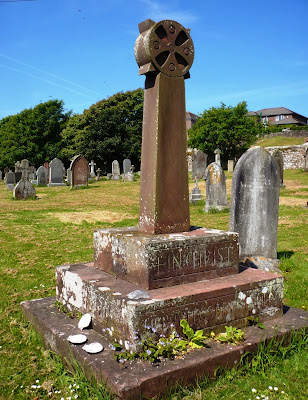The many interesting gravestones in the churchyard include this one which is known locally as "The Sailors Grave" and commemorates the souls of the seamen from wreck of the 'Luigi Olivari', only one which could be identified, the pilot Henry Legg, and this from his pilot certificate which was kept safe enclosed in a tin in his pocket. The cross is dedicated to him and the other 11 unknown sailors. The three shells seen on the left complement many on the back and have been there as long as anyone can remember. The old people in the village remember them being there as children but no-one knows who put them there.
Walking out of the village to the sea and the most westerly part of Cumbria are the sandstone cliffs of St Bees Head. This is also the start of the 182 mile coast to coast walk across northern England where tradition has it to dip your feet in the Irish Sea here (or bike wheel if doing the C2C), and after passing through three contrasting national parks reaching the end at Robin Hoods Bay to do the same in the North Sea. The preferred route is usually west to east because, as the Irish blessing goes, the wind is ever at your back. I however am heading north.
along the coastal path on a warm June day, and a summer that abounded in buttercups. The views were hazy but in the distance can be seen the St Bees Lighthouse
and the path crosses inbetween that and the
coastguard lookout. The sea here merging with the sky it was so calm.
which the occupants of these cliffs were enjoying for turning around the corner there were
thousands of black guillemots. They almost look like dark pieces of rock from a distance but crop
a photo and here they all are. Over the last fifty years their numbers have increased but many sea-birds stop here including Razorbills which come to breed from March to July. If lucky there are also a few Puffins,(not on this day) but there is no shortage of many other species to be seen whirling over the sea and sky.
An entry to ABC Wednesday, a journey through the alphabet, this week sojourning at S












8 comments:
Very interesting information with wonderful images.
How SPECTACULAR!
Beautiful country and the scenery is stupendous.
I would love to do that journey from West to East. I dipped my toes in the Atlantic Ocean at Prince Edward Island and then again at Biarritz in France. I'm going to put this on my bucket list and do the same using the Irish and North Seas!
Leslie
abcw team
Thank you for this wonderful post along the seaside! Great Britain is so beautiful and filled with legends every where!
Wil, ABCW Team
I love the seaside!
The same birds can be found in abundance on the East Coast, but they also have quite a few puffins. The countryside looks about the same, but the cliff to the south of Scarborough are chalk.
Great series!
And what a beautiful place to visit!
Love the seaside too!
Post a Comment